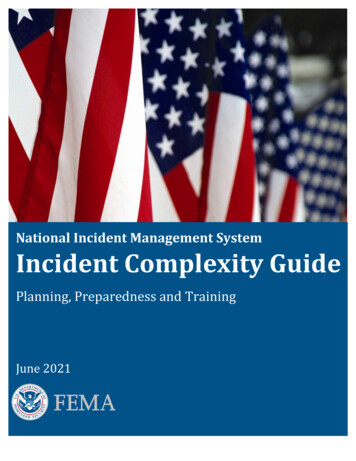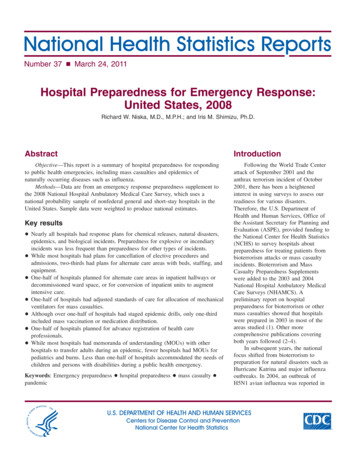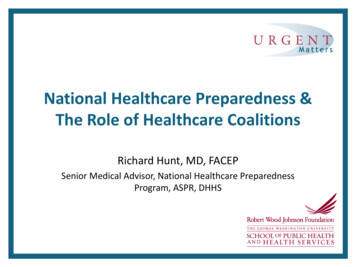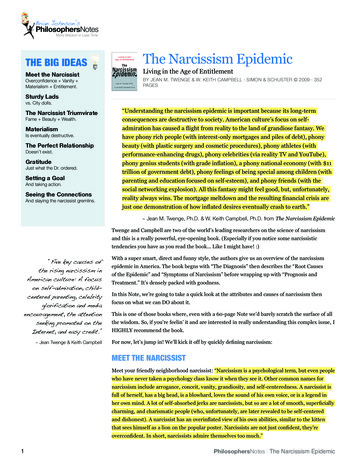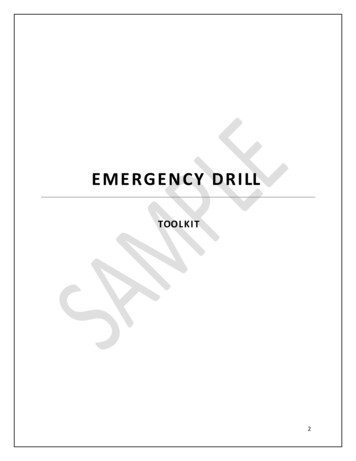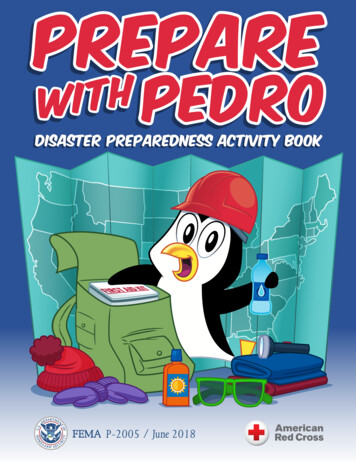
Transcription
A project of Resolve to Save Livespreventepidemics.org resolvetosavelives.orgStrengthening EpidemicPreparedness at the Country LevelISSUE BRIEFIn partnership withIn partnership with
STRENGTHENING EPIDEMIC PREPAREDNESS AT THE COUNTRY LEVELSince the emergence of COVID-19, multiple internationalbodies have reviewed the world’s preparedness for andresponse to epidemics and pandemics, producing dozens ofrecommendations1 on adapting and strengthening our globalhealth so that it is fit-for-purpose for the next health threat.And yet, even as the world continues to grapple with the COVID-19pandemic, far less attention has been paid to the country-levelarchitecture required for a better protected world. As the globalpublic health community begins revising the International HealthRegulations (IHR 2005)2 and negotiating a new pandemic prevention,Global healthsecurity must beginwith preparednesspreparedness and response instrument, we must ensure that suchand responseendeavors are informed by real-world efforts to improve country-infrastructure at thelevel public health infrastructure, and that countries are notcountry level.forgotten as the front lines of effective preparedness and response.The challengesImproving country-level preparedness is an inherently difficult, complex, incrementalprocess with no shortcuts. Rather than “filling gaps,” a more accurate metaphor is “travelingtoward a destination.”Research shows that a country’s performance during an infectious disease outbreak is linked to its abilityto partner across and beyond health stakeholders; coordinate at national and subnational levels withappropriate political leadership; engage communities; and continuously develop and strengthen healthand public health system capacity to prevent and stop outbreaks.Country efforts to enhance public health tend to be slow and uneven for many structural reasons, including: Insufficient human resources: Many countries rely on emergency response teams to carryout preparedness work in the rare downtime between responses, leaving preparedness activitiesunattended, de-prioritized and implemented in a start-stop manner. Limited funds: The Task Force meeting of the G20 Health and Finance track estimates that nationalgovernments invest just 1% to 3% of their health care spending on pandemic preparedness andresponse. Resources available from international partners are insufficient.3 Unlike vertical diseaseprograms that measure specific outcomes (e.g., lives saved or reduction of disease burden), successin epidemic and pandemic preparedness is defined by the absence of large-scale disease events. Thelack of obvious, measurable, reportable outcomes for successful responses discourages investment orfavors short bursts of funding only when an immediate threat is perceived.1 Survey on implementation of COVID-19 recommendations: preliminary findings2 This includes work by the Independent Panel for Pandemic Preparedness and Response (IPPPR), established by the World Health Organization (WHO) Director-General inresponse to World Health Assembly resolution 73.1, and work by the High High-Level Independent Panel (HLIP) on Financing the Global Commons for Pandemic Preparednessand Response established by the G20.3 Overall Development assistance for health (DAH) is estimated at around 40B per year with a small share, estimated at around 1-2.5%, directed at supporting core pandemicpreparedness and response functions at global and country level.2
STRENGTHENING EPIDEMIC PREPAREDNESS AT THE COUNTRY LEVEL Inadequate program management andwhich governments can identify points ofunderutilization of existing funds: Weakfailure and bottlenecks across responses toprogram management and planning can lead topublic health threats. There is little real-timelimited absorption capacity and underspending.visibility on NAPHS implementation, includingPreparedness personnel tend to be highlyactivities funded by multilateral organizations,technically skilled (e.g., epidemiologists,development banks or bilateral donors, hinderingdoctors), but often lack experience in complexthe ability of designated agencies or divisions toprogram management, leadership andtrack progress, identify and address emergentcoordination, which are all required to prioritize,bottlenecks in a timely manner, plan efficientlytrack and implement preparedness. This isand coordinate overall implementation of well-exacerbated by international funding that isprioritized NAPHS activities. This limitationunpredictable, piecemeal, heavily earmarkedalso allows after-action reviews to devolve intoand complex to administer.political blame games or vague speculations, Insufficient prioritization and limitedproject management expertise: NationalAction Plans for Health Security (NAPHS)stalling collective efforts to leverage high-yieldopportunities for system improvements. Underinvestment in multisectoralare among the most complex planningcollaboration: COVID-19 has put theprocesses in public health, with multisectoralinterlinkages among public health, socio-interdependencies across 19 different technicaleconomic, political and security challenges intoareas. Countries face big challenges insharp relief. Still, efforts to drive multisectoralprioritizing and sequencing activities across thecoordination to prepare and respond to health19 technical areas: the first 100 Joint Externalthreats tend to be limited and lack focus,Evaluations (JEE) identified more than 7,000concrete actions and deadlines; ineffectivegaps in preparedness capacity. Without rigorousmultisectoral coordination is often a source ofapproaches to ensure prioritization, plans tendsignificant delays, hindering full implementationto be unwieldy and difficult to execute.of the IHR (2005). Lack of real-time metrics and diffuse Insufficient political will and clearaccountability: The prevailing global standardgovernance structures: Weak politicalfor measuring epidemic preparedness, thesupport at the highest level of government andMonitoring and Evaluation Framework of theunclear or competing public health-relatedIHR (2005), including the State Party Self-authority among governmental structures canAssessment Annual Reporting (SPAR), doesmake it difficult to implement preparednessnot include straightforward mechanisms byefforts efficiently.These hurdles cannot be tackled through one-off engagements from countries’ technical partners.Country-driven approaches that are both practical and sustainable are necessary to strengthenpreparedness infrastructure and are essential—not only to better protect countries, but also as thefoundational building blocks to protect the world.3
STRENGTHENING EPIDEMIC PREPAREDNESS AT THE COUNTRY LEVELExperience-informed recommendationsOver the past five years, the governments of seven African countries in partnershipwith Resolve to Save Lives (RTSL), have piloted different approaches to strengtheningpreparedness.This experience includes: Strengthening the program management capacity of government stakeholders involved inpreparedness; Establishing multi-disciplinary teams dedicated to accelerating implementation of the NationalAction Plan for Health Security (NAPHS) with a focus on prioritization of activities, progressmonitoring, facilitating partnerships and enhancing accountability; Advocating to elevate preparedness as a political priority, including increased financing; Supporting the enhancement of legal frameworks to enable preparedness; and Rolling out timeliness metrics to support rapid and continuous improvement and increasedaccountability.Five core recommendations have emerged from these efforts and can inform government,donor, partner and global approaches to strengthening country-level preparedness:123Activate politicalEstablishAdopt anSet up timelinessStreamlineleadership andmultidisciplinaryaccessiblemetrics to drivepartnershipsa multisectoralteams dedicatedtrackingcontinuousand align donorscoordinationto preparedness.system forimprovement andand nism.of national45providers.preparednessplans.4
STRENGTHENING EPIDEMIC PREPAREDNESS AT THE COUNTRY LEVEL1Activate political leadership and a multisectoral coordination mechanism that isefficient, accountable and supports progress in each of the sectors where it is needed.COVID-19 has shown that although preparedness systems are necessary, they are not sufficientto address health threats without effective leadership. Capacity and leadership are necessary andcomplementary, and neither on its own is sufficient to meet health security challenges. In practical terms,this means that technical engagement and leadership of countries’ ministries of health (MoHs) can onlysuccessfully prepare for health threats if a commitment is made at the highest levels of government(president or prime minister) to elevate preparedness above the MOH to include other sectors, sustainpolitical will to ensure appropriate attention and investments over time, and ensure accountability tocitizens, neighboring countries, partners and donors. Regular reporting to the highest level (leveraginganalysis from the below-mentioned tracker) can also generate and help sustain the political will necessaryto break down silos among human, animal, environment and other relevant sectors.Relatedly, the establishment or strengthening of One Health platforms with well-defined responsibilitiesand coherent strategy, outcomes and dedicated secretariat support can help various ministriesunderstand and implement their roles and obligations under the IHR (2005) and establish frameworks forclear decision-making that is informed by risk, rather than politics. In this regard, dedicated preparednessteams (see Recommendation 2) with multidisciplinary skills and experience, and partnerships withdifferent sectors can stimulate and sustain engagement across sectors. Ongoing engagement isnecessary for continuous monitoring, learning, calibration and adjustment of multisectoral efforts. InEthiopia, for instance, the dedicated preparedness team has been working closely with the national OneHealth steering committee and One Health partners, as well as the national emergency coordinationcommittee, to ensure they have a shared agenda rooted in the NAPHS, are advancing mutually reinforcingactivities, communicating about unexpected threats or challenges and periodically recalibrating their plans.2Establish multidisciplinary teams dedicated to preparedness.Preparedness is a complex and specialized area of public health that requires dedicated human resources.COVID-19 has demonstrated how factors across all health sectors—from readiness of health facilities torisk comunications — affect the trajectory of an infectious disease threat. Countries and donors shouldconsider establishing dedicated, multisectoral teams to accelerate the implementation of NAPHS andtrack progress (“dedicated preparedness teams”). Pilots (see Box 1) have shown that with the supportof a core group of partners and committed national leadership, countries with established, dedicatedpreparedness teams outperformed others in preparedness improvement as measured by the State PartySelf-Assessment Annual Reporting (SPAR). Between 2018 and 2020, Nigeria’s SPAR score improved by3.8%, Ethiopia’s by 15% and Uganda’s by 35%.5
STRENGTHENING EPIDEMIC PREPAREDNESS AT THE COUNTRY LEVELDedicated Preparedness TeamsIn the Democratic Republic of Congo, Ethiopia, Nigeria and Uganda, Resolve to SaveLives has partnered with governments to design, fund and implement pilot programs thatenabled dedicated, multi-disciplinary teams to catalyze preparedness.RTSL embedded staff within Ministries of Health or National Public Health Institutions andprovided targeted training, financial resources including leveraging programs of the WorldBank and others, and facilitated knowledge exchange among countries.The teams have steered multi-sectoral coordination and implementation of NationalAction Plans for Health Security, with a focus on partnering across departments andstakeholders and increasing prioritization, accountability and monitoring of progress.Specific country contexts and government priorities should determine the institutional positioning andcomposition of a dedicated preparedness team. For example, a country with a federated political structuremay have its preparedness team focus on the subnational level. Regardless of how it is structured, theteam must be anchored to an appropriately authorized political coordination mechanism to be successful;the exact scope of work, reporting relationships and protocols for government agency partnerships willdiffer depending on national priorities and needs.MonitoringandEvaluationCoreCompetenciesOne Health:human,animal rveillanceLeadership,communicationand negotiationLegalandAdvocacy6
STRENGTHENING EPIDEMIC PREPAREDNESS AT THE COUNTRY LEVELAuthorized focal pointIndividual or entity authorized to lead multisectoralcoordination on preparednessTeam leadManagement, leadershipand public health expertiseHuman healthadvisorLegislation andpolicy advisorCommunicationsadvisorOne HealthadvisorMonitoring andevaluation advisorManagement,leadership and publichealth expertiseLegal tyAnimal,environmentaland human healthMeasurement andquality improvementexpertiseengagementand riskcommunicationsexpertiseexpertise The team can include experts with different specialties (e.g., health security, veterinary publichealth, monitoring & evaluation, legal, communication) based on country needs. The team can be attached to NPHIs or specific divisions within the MoH, depending on whereNAPHS leadership is located. In Ethiopia, a dedicated preparedness team is embedded withinthe Ethiopian Public Health Institute, which has led preparation of NAPHS and is coordinatingits implementation in collaboration with the emergency coordination committee, strengtheningpreparedness and response to public health and humanitarian crises. In Uganda, the team isstationed at the MoH under the Office of the Director-General Health Service, and reports to theDepartment of Integrated Epidemiology, Surveillance and Public Health Emergencies and PublicHealth Emergency Operations Centre, collaborating with the Office of the Prime Minister, othergovernment agencies and implementing health security partners. Dedicated preparedness teams can support the synthesis of various risk and capacity assessments;development, prioritization and implementation of realistic preparedness plans based on capacityassessments; alignment with existing donors and financing structure (such as the World Bank’sREDISSE and other projects set up to reinforce surveillance and response systems againstinfectious diseases in the wake of the West African Ebola epidemic); identification and reconciliationof resource gaps; applying learning from performance during real-world events to improve earlydetection and response; establishing tracking systems to monitor progress and inform the strategicpiloting of activities; facilitation of partnerships; strengthening of One Health coordination; andenhancement of collaboration across departments and sectors.7
STRENGTHENING EPIDEMIC PREPAREDNESS AT THE COUNTRY LEVEL Progress is accelerated when teams are 100% dedicated to preparedness yet still linked closelyto clinical services and epidemic response to ensure the lessons learnt and gaps identified areintegrated quickly into planning and implementation. For this to occur, countries require adequatestaff dedicated to response activities that have access to rapid response funding.3Adopt an accessible tracking system to steer NAPHS implementation and strengthenaccountability.NAPHS are amongst the most complex planning processes in public health, with multisectoralinterdependencies across 19 different technical areas. The plethora of activities included in NAPHStends to lack adequate prioritization and resourcing, and typically, there is little real-time visibilityon activity implementation progress, including those activities funded by multilateral organizations,development banks or bilateral donors. This hinders the ability of designated agencies or divisions to trackimplementation and funding status, identify and address emergent bottlenecks in a timely manner, planefficiently, and coordinate overall implementation of well-prioritized NAPHS activities.Prioritization of the NAPHS into a 12-month operational plan has helped drive coordination, focusimplementation and support alignment across departments. Countries can set up a NAPHS trackingsystem to facilitate coordination and accountability across ministries and departments and mobilizeresources. Having a shared and current overview of NAPHS progress can help countries continuouslyrefine their plans by prioritizing actions, informed by real life experience (including after-action reviews) oralignment with other opportune national development priorities.Since 2018, several countries including Nigeria, Uganda, Ethiopia, Liberia and the DRC have adoptedcustomizable, online, open-source database and data visualization tools (“trackers”) to track andpilot NAPHS activities. In these countries, tracker use has helped generate an accurate and sharedunderstanding of NAPHS implementation progress; facilitated multi-sectoral collaboration by providingreal-time data access to technical leads and implementers across sectors; increased accountability byassigning activities to pre-identified stakeholders; and provided an efficient way of summarizing andcommunicating the data to inform decision-making. The tracker provides senior officials with a big-pictureview of the NAPHS program and helps stakeholders find implementation bottlenecks more easily anddevise the necessary technical, operational, financial or political interventions needed to tackle them.8
STRENGTHENING EPIDEMIC PREPAREDNESS AT THE COUNTRY LEVEL4Set up timeliness metrics to drive rapid and continuous performance improvementthat is easily communicated.Being ready for an epidemic on paper does not necessarily result in strong real-world performance.Measuring a country’s ability to respond requires a review of how all elements of the health securitysystem — from laboratories and surveillance to health coverage and leadership — work together to detectand respond to disease threats. One way to assess how well country systems work is by measuringtimeliness: a start-to-end assessment of the speed with which real-world infectious diseases threats aredetected, public health authorities are notified, and an effective response is mounted.Using the 7-1-7 target, in which countries aim to identify everysuspected outbreak within 7 days of emergence, reportit to public health authorities with initiation ofinvestigation and response efforts within 1day, and effectively respond within 7 days,can help identify bottlenecks and pointsof failure and improve performance.Applying 7-1-7 timeliness metrics to realworld experiences can inform NAPHSprioritization and help preparednessteams simplify and accelerateimplementation while fostering a culture ofrapid and continuous quality improvement.The 7-1-7 framework also provides a clear wayApplying 7-1-7 timeliness metrics toreal-world experiences can informNAPHS prioritization and helppreparedness teams simplify andaccelerate implementation whilefostering a culture of rapid andcontinuous quality improvement.for NPHIs and MoHs to communicate with thepublic, political leadership and donors about whereimprovements have been made and where additionalTime to NotifyTime toareDetect(7 Days) as well as documenting(1 Day)funding and supportneeded,theTime to Complete Initial Response (7 Days)success of finding and stopping outbreaks before they occur or spread.Pilot countries met at least one 7-1-7 target in approximately half of their outbreaks, but met all threetargets in only about 1 in 4 outbreaks, demonstrating that the targets are realistic but that manybottlenecks exist, some of which are not captured by the SPAR and JEE. 7-1-7 reviews have highlightedchallenges that are concretely tethered to the operational capacity of systems, and provide a metricdemonstrating the impact of interventions and a pathway to rapid improvement.9
STRENGTHENING EPIDEMIC PREPAREDNESS AT THE COUNTRY LEVEL5Streamline partnerships and align donors and technical assistance providers in thehealth security space to improve support for priority activities.Despite efforts to achieve better alignment, fragmentation is an enduring feature of the global healthlandscape and undermines the effectiveness of health programming, including in public health and healthsecurity. African health leaders have, over the years, repeatedly urged development partners to bettercoordinate their efforts when supporting countries in strengthening their health systems toward achievinguniversal health coverage and health security. Yet donors and partners continue to lack coordination andtheir activities are often duplicative and include high transaction costs, while important gaps remain.Dedicated preparedness teams can enable higher-quality engagement with stakeholders and buy-in forimplementation. In Uganda, the team was equipped to align new and existing development partners anddonors to accelerate implementation of the country’s NAPHS. The team strategically used costing tools toefficiently estimate resource requirements and build political and institutional support from the broaderdomestic development plan, giving them the gravitas and ability to synchronize international technical andfinancial partners (e.g., FAO, USAID, U.S. CDC, MSF) to prioritize, accelerate and effectively utilize existingresources to match the national health security agenda.Technical rigor, political leadership and operational excellenceare all needed to manage the complexity of strengthening healthsecurity across sectors, deepening systems that build trustand put communities at the center, enhancing evidence-baseddecision-making, and improving accountability.The five steps outlined in this brief can help countries make substantial,steady and sustained progress towards protecting their people, theirneighboring countries and the world. Global health security must beginwith preparedness and response infrastructure at the country level.1234510
STRENGTHENING EPIDEMIC PREPAREDNESS AT THE COUNTRY LEVELA very special thank you to the signatories of this document:Dr. Da Costa AboagyeDr. Daniel NgamijeDirector of Health Promotion, Ghana Health Service &Minister of HealthNational Lead of RCCE for Ghana’s COVID-19 ResponseRwandaGhanaDr. Aceng Jane Ruth OceroMinister for HealthDr. Ifedayo AdetifaRepublic of UgandaDirector-GeneralNigeria Centre for Disease ControlProf. Adrian PurenExecutive DirectorDr. Anthony Nsiah AsareNational Institute for Communicable DiseasesPresidential Advisor on HealthSouth AfricaOffice of PresidentJubilee HouseDr. Ahmadou Lamin SamatehGhanaMinister of HealthThe GambiaMustapha Bittaye(MBChB, MSc,MGCPS,FWACS)Dr. Awa Marie Coll SeckDirector of Health ServicesMinister of State to the PresidentMinistry of HealthSenegalThe GambiaDr. Lia TadesseDr. Janneth MghambaMinister of HealthHealth AdvisorEthiopiaSocial Policy Development - Health SectionThe Commonwealth Secretariat302 PE 0522 Rev A
program management and planning can lead to limited absorption capacity and underspending. Preparedness personnel tend to be highly technically skilled (e.g., epidemiologists, doctors), but often lack experience in complex program management, leadership and coordination, which are all required to prioritize, track and implement preparedness .



